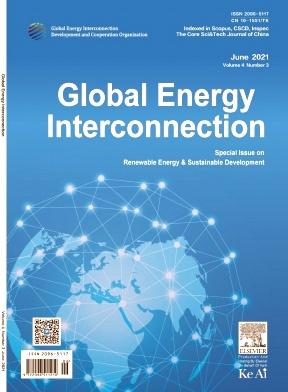尼日利亚不同地区间歇式可再生能源制氢的潜力:技术、经济和环境视角
IF 2.6
Q4 ENERGY & FUELS
引用次数: 0
摘要
在这项研究中,使用了10个风力涡轮机和14个太阳能光伏(SPV)模块来比较尼日利亚六个地缘政治区域风能和太阳能资源的氢气生产潜力。以产氢量为技术参数,以制氢成本为经济指标,以柴油使用节省的氧化碳(IV)量为环境指标。结果显示,ENERCON E-40涡轮机在拉各斯,乔斯,索科托,包奇和埃努古站点产生最高的容量因子,而FUHRLAENDER, GMBH在Delta产生最高的容量因子。S6站点(Delta)的平均年风能产氢量为2.05吨/年,S3站点(索科托)的平均年风能产氢量为17.33吨/年,S1站点(拉各斯)的平均年SPV产氢量为64.33吨/年,S6站点(Delta)的平均年氢气量为140.28吨/年。S3和S6站点的风能制氢成本分别为6.3679和25.9007美元/kg, S3和S1站点的SPV制氢成本分别为5.6659和6.1206美元/kg。在S6基地,风能制氢每年节省的二氧化碳量为137,267 kg/年,在S3基地为504,180 kg/年,并用于通过燃料电池发电。在S1和S6站点,使用SPV产生的氢气节省的二氧化碳量分别为615,400 kg/年和1,341,899 kg/年。结果还表明,与风力资源相比,s1 ~ s6的SPV产氢量分别增加了75.55%、88.93%、80.28%、80.54%、85.65%、98.53%。本研究为相关政府机构、政策制定者和投资者提供了可靠的技术信息来源,有助于他们就尼日利亚氢经济的最佳投资做出明智的决策。本文章由计算机程序翻译,如有差异,请以英文原文为准。
Potential of hydrogen production from intermittent renewable energy resources in different locations of Nigeria: Technical, economic and environmental perspective
In this study, ten wind turbines and fourteen solar photovoltaic (SPV) modules were employed to compare the potential of hydrogen production from wind and solar energy resources in the six geopolitical zones of Nigeria. The amount of hydrogen produced was considered as a technical parameter, cost of hydrogen production was considered as an economic index, and the amount of carbon (IV) oxide saved from the use of diesel fuel was considered as an environmental index. The results reveal that ENERCON E-40 turbine yields the highest capacity factor in Lagos, Jos, Sokoto, Bauchi and Enugu sites while FUHRLAENDER, GMBH yields the highest capacity factor in Delta. The mean annual hydrogen production from wind ranged from 2.05 tons/annum at site S6 (Delta) to 17.33 tons/annum at site S3 (Sokoto), and the mean annual hydrogen production from SPV ranged from 64.33 tons/annum at sites S1 (Lagos) to 140.28 tons/annum at site S6 (Delta). The cost of hydrogen production from wind was 6.3679 and 25.9007$/kg for sites S3 and S6, respectively, and the cost of hydrogen production from SPV was 5.6659 and 6.1206$/kg for sites S3 and S1, respectively. The amount of CO2 saved annually from wind-based hydrogen generation was 137,267 kg/year in site S6 and 504,180 kg/year in site S3, and was used to produce electricity via fuel cells. The amount of CO2 saved using hydrogen produced from SPV was 615,400 kg/year and 1,341,899 kg/year in sites S1 and S6, respectively. The results also revealed that 75.55%, 88.93%, 80.28%, 80.54%, 85.65%, 98.53% more hydrogen could be produced from SPV for sites S1–S6, respectively, compared to the wind resources. This study serves as a source of reliable technical information to relevant government agencies, policy makers and investors in making informed decisions on optimal investment in the hydrogen economy of Nigeria.
求助全文
通过发布文献求助,成功后即可免费获取论文全文。
去求助
来源期刊

Global Energy Interconnection
Engineering-Automotive Engineering
CiteScore
5.70
自引率
0.00%
发文量
985
审稿时长
15 weeks
 求助内容:
求助内容: 应助结果提醒方式:
应助结果提醒方式:


